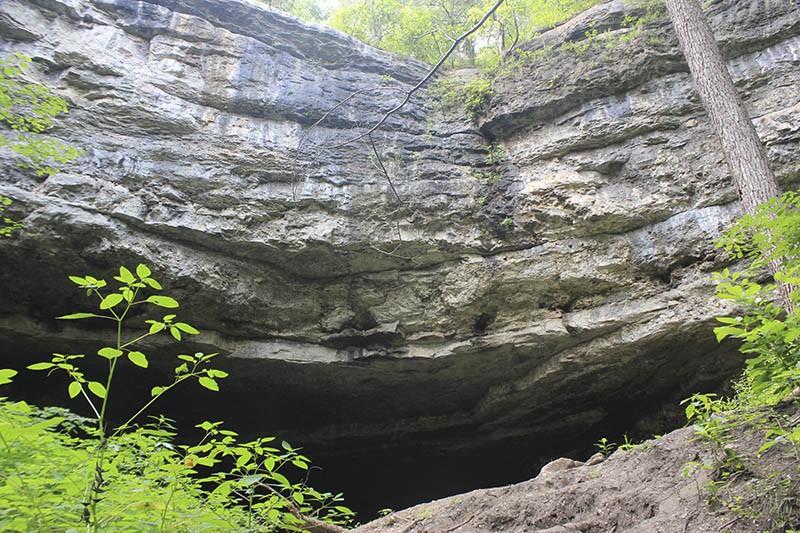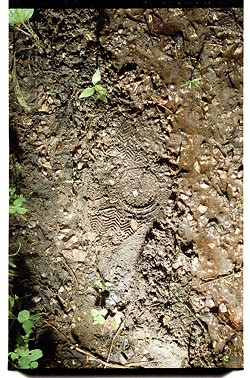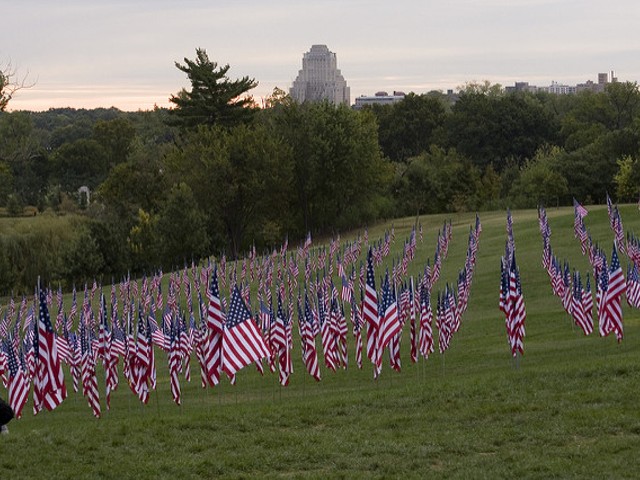
On the morning of July 7, 1992, a teenage brother and sister visiting the Rolla area from O'Fallon followed a gravel road around blind curves and steep declines to where it ends at the edge of a stream. Their grandfather had shown them the way to Gourd Creek Cave the night before, and they returned that Tuesday to explore.
The cave is a local secret. Four miles off the main highway and hidden away on unguarded private land, generations have sneaked in at night to drink beers along the path leading to the cave mouth. Tall trees hang overhead like the crest of a tunnel. Even in full daylight, it's shadowy and still.
The teen hikers parked at the trailhead and began to climb the rocky incline. They were less than two minutes into their hike when they stopped in horror. A large amount of blood had pooled midway up the trail.
The teens looked left and spotted another, smaller pool, and then one more just ahead. The fifteen-year-old boy's eyes scanned the ground and froze on a body lying halfway in the creek. The man was face up, tilted onto his left side. Water from the stream trickled past his bloodied head, and flies gathered at his eyes, nose and mouth.
The teens took it all in, and then they ran — racing up the road to their grandfather's house to call for help.
It was just after 8 a.m. Within an hour, Phelps County sheriff's deputies and a Missouri State Highway Patrol sergeant were combing the woods. They snapped pictures of anything that looked out of place or that was smeared with blood. A piece of carpet stained red, a cigarette filter left in one of the pools, a plastic laundry basket discarded near the body and an empty beer can sheathed in a black Harley-Davidson koozie were all photographed and packed into evidence bags.
The left side of the man's head was swollen, he had a large cut on his shoulder and there was a bullet hole behind his left ear. Detectives found his wallet lying next to him. It was still attached to his belt, empty except for a few personal papers with phone numbers for people in the small town of Cuba, about 35 miles northeast of the cave.
Investigators took careful note of footprints near the body. The gym shoe pattern came out pretty clear in the mud. The distinctive feature was a circle at the forefoot.
The case broke quickly. Using phone numbers from the wallet, investigators identified the dead man as 26-year-old Jerry Wayne King, a sawmill worker and father of two young boys, and started tracing his movements through the previous 24 hours.
Before nightfall, troopers took King's longtime drinking buddy, Bill Harrison, into custody. He was charged with first-degree murder that same night. Before Harrison was sent off to lockup, the highway patrol sergeant seized Harrison's Reeboks and added them to the evidence pile.
Bill Harrison and his friends were a work-hard, play-hard crowd back in the 1980s and 1990s. They drank. Some used drugs. They raised a little hell in Rolla and nearby small towns such as Cuba and St. James.
"Getting drunk, hanging around bragging about how great they are" is how Harrison's third ex-wife, Linda Harrison, describes it.
An old railroad town, Rolla is home of one of the nation's most respected engineering schools in the Missouri University of Science and Technology. Access to world-class outdoor activities in the Ozark Highlands, a relatively low crime rate and a town-and-gown culture have over the years landed it on lists of best small towns in America.
But it's always had a rough undercurrent of blue-collar workers who've scratched a life out of the tall forests and rocky ground. Early settlers considered naming the county seat Hardscrabble, but North Carolina transplants eventually chose Rolla as a phonetic spelling of Raleigh, according to town legend. These days, it's become something of a hideout for small-time fugitives from St. Louis who are convinced metro cops won't seek extradition beyond 100 miles for minor crimes. Rolla is 101 miles from the city.
In his twenties, Harrison ran with a crew of calloused laborers who spent their paychecks from the timber companies and sawmills on whiskey and secondhand truck engines. Linda Harrison says she told him if he and his friends were going to drink themselves stupid, he should just stay away, and he sometimes took her advice, leaving home on multi-day benders.
"He was a drunk," she says. "He was an idiot."
Harrison says he was a hard worker with a good reputation. In the 1990s, he worked for a rental company, refurbishing and repairing mobile homes. The small crew of friends he hired to help with the work often included at least one of the Faulkner boys, a rough-and-tumble bunch whose transgressions ranged from drunken driving to violence. Harrison was closest to Henry Faulkner, but he knew Whitey and Pee Wee, too. A younger half-brother, Marion "Winker" Ray, who is now serving time on assault and weapons charges, sometimes joined the crowd.
Jerry Wayne King was right in the middle. He'd dated Henry's sister Venita Faulkner for about seven years, and they had a little boy, Justin, who was six years old in 1992. (Another son, seven-year-old Stephen, lived with King's ex-wife.) King worked as a forklift driver at McGinnis Wood Products, a company in Cuba that turned out white ash bourbon barrels. But he lived for the weekend.
The drinking eventually drove a wedge between King and Venita Faulkner. He'd be gone for "two or three days at a time," she says, carousing. Her brothers might have liked to run around and hang out, but that wasn't the life she wanted.
"I just never was a partier," she says. "I had a baby to take care of."
She didn't like Harrison. She claims he tried to put the moves on her at a New Year's party. She eventually told King who, she says, told Harrison's then-wife, Linda. When Harrison learned about King's meddling, he grabbed King by the throat and threw him up against a wall, Venita Faulkner claims.
King and Harrison stopped hanging out for a while after that, but eventually made amends. Venita Faulkner says she's not sure what happened. She took their son and left King in the fall of 1991.
Not long after, prosecutors claim, Harrison and King quarreled again in what would ultimately become a motive for murder.
In early 1992, King was living with a new girlfriend in Cuba, and they were looking for a new place. They gave Harrison a $100 deposit on a mobile home but ultimately decided not to move in.
Harrison held onto the deposit since holding the trailer had cost him a month or two of rent. He says it wasn't a big issue and King understood. The two continued to hang out and drink together after the deal fell apart. But others claim Harrison was angry about the situation.
In prosecutors' version of the story, things came to a head during a long July Fourth weekend in 1992. Harrison invited his buddies over to his cabin on the Gasconade River in Maries County. Friends flowed through from Friday on into Tuesday morning. Investigators struggled to pin down all the names and times for the revolving guest list. With all the drinking and partying, Harrison says he can't quite remember either.
"It was a pretty heavy weekend," he says.
Henry Faulkner, the brother of King's ex-girlfriend, was there — probably Sunday night into Monday, based on what investigators could gather from witnesses and his previous statements. But he's varied on the timeline over the years. Now dying of alcohol-induced pancreatitis, he tells the Riverfront Times he's pretty sure it was Friday night.
Cloudy though he was on the details, Faulkner's testimony became one of the critical pieces in the case against Harrison. In an interview with the highway patrol the day after King's body was found, he suggested that the argument over the trailer had led to real animosity between Harrison and King — that, in fact, Harrison "told me that that he was going to kill Jerry King over it." Investigators would seize on that claim and make it a focal point of their case.
A third man at the cabin that weekend, John Lister, would also draw their attention. A tall, thin 29-year-old, Lister tended to keep to himself. He was a bit of a mystery to the others. He wasn't as much of a drinker as the rest of the guys, and Harrison seemed to be his only link to the crew. He brought out his kids to swim and eat at some point during the weekend, but then returned to Rolla.
The crowd had thinned by Monday night. Harrison is believed to have driven a drunken Henry Faulkner back to a brother's house and dropped him off.
Harrison, who was plenty drunk himself, then drove over to King's place in Cuba, where neighbors and coworkers from the barrel company were having a keg party. (Accounts of this sequence of events have varied. At least one investigator has said Harrison still had Faulkner with him when he arrived in Cuba.)
Witnesses, including King's girlfriend, say Harrison promised to repay the $100 if King would ride back to his place with him to get the money. That was about 10:30 p.m.
What happened next is a little less clear.
Harrison says they drove around and drank beers, eventually making it to his house at 1 a.m. He was able to mark the time because his stepdaughter was up watching television, and she told detectives she remembers him and King arriving as she waited for her next show to start.
Harrison's wife had been asleep but woke when he came in. She told investigators he kissed her goodbye and said something about needing to "take care of business" before he and King headed out the door.
Harrison says there's not much more to it than that. He claims King wanted to keep drinking, so he dropped him at a roughneck Rolla bar called the Top Hat.
"He wasn't done," Harrison says. "And I was overdone."
Harrison says he then steered his pickup over to Lister's house and woke him up between 1:30 and 2 a.m., hoping to persuade him to drive him back up to the cabin in Maries County. Lister told investigators Harrison was wasted, and he tried to persuade him to sleep it off there, but Harrison was insistent on returning to the Gasconade.
Harrison eventually won out, and Lister took the keys to the Chevy and drove them out to the cabin. They drank a few beers and ate leftover barbecue, according to Lister. Finally, about 4 or 5 a.m., they returned to town with Harrison passed out in the truck. Lister couldn't wake him, so he left him in the cab of the Chevy and went to sleep for a few hours before driving him home at 8 a.m.
This is Harrison's account, too. But prosecutors say it doesn't match what he first told investigators just before his arrest in 1992.
After the hiking teens stumbled onto King's body later that morning, it didn't take long for detectives to conclude Harrison was the last man to see King alive.
Harrison originally claimed he'd dropped King at the Top Hat about 10:30 p.m. and spent the rest of the night away from home, investigators said. When they told him his wife reported seeing him about 1 a.m. with King, he quickly altered his timeline and recalled dropping by his home early that morning, according to notes from the interrogation.
Curiously, he also admitted visiting Gourd Creek Cave recently. He claimed he and his crew had worked a job nearby a day or two before the killing, and he drove them over because some had never seen it.
An ambitious lawyer named John Beger was the Phelps County prosecuting attorney back in 1992. He looked at the case in front of him: Henry Faulkner claimed that Harrison said he was going to kill King. King was last seen alive with Harrison about 1 a.m. Hikers discovered King in a hard-to-find locale known to Harrison. And then investigators found "inconsistencies" in Harrison's timeline.
They didn't find the murder weapon — or any guns — despite a search of the cabin and Harrison's home and pickup. They also didn't have any witnesses to the killing, and the only physical evidence linking Harrison to the crime scene was a possible match between the muddy shoe prints and the Reeboks seized from Harrison after his arrest. Accent on "possible" — the shoe and prints had the same pattern down to the circle on the forefoot, but Reebok wasn't exactly an obscure brand and the sizing of the rain-soaked impressions was unclear.
But Beger decided they had a strong circumstantial case based on the timeline and statements from witnesses such as Henry Faulkner. On Wednesday, just one day after King's body was found, Beger formally charged Harrison with first-degree murder.
The case would quickly crumble. Beger says now they ran into some "evidentiary" problems in the following months. The challenges became so great, he says, he decided to dismiss the charges "without prejudice," meaning they could be refiled in the future.
Beger left office shortly after the case and went into private practice after a failed campaign for judge. The evidence was piled into boxes and filed away. Investigators turned to new cases.
Still, the murder nagged at Beger for years.
"I never did forget the case," he says, "but I was out of office and didn't have any authority."
That changed in 2010, when Beger decided to run for his old seat again. He won and reclaimed the prosecutor's office in 2011. About two years later, he called up a newly retired sheriff's detective and asked him if he'd be interested in a project. Would he mind taking a look at an old murder?







